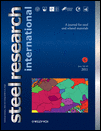Corrosion Behavior of TiC Particle-Reinforced 2Cr13 Stainless Steel
Abstract
The corrosion behavior of TiC particle-reinforced 2Cr13 stainless steels prepared by in situ reaction and electroslag remelting (ESR) was investigated using potentiodynamic polarisation measurements and immersion tests. The addition of TiC particles to 2Cr13 stainless steel impeded rapid pit propagation but maintained a high corrosion rate in the whole immersion time investigated. The TiC addition developed finer matrix structure, the formation of Cr-rich carbides and high dislocation density around the TiC particles before corrosion, which results in an increasing corrosion rate and preferential pitting attack at the steel matrix/TiC interface. Although the corrosion resistance of 2Cr13 stainless steel is sharply decreased due to TiC addition, it is significantly improved after the ESR process. This is attributed to the more uniform distribution and smaller size of TiC particles, the increase of value of χ in TiCχ and the elimination of the porosity in TiC particle-reinforced 2Cr13 stainless steel after the ESR process.




